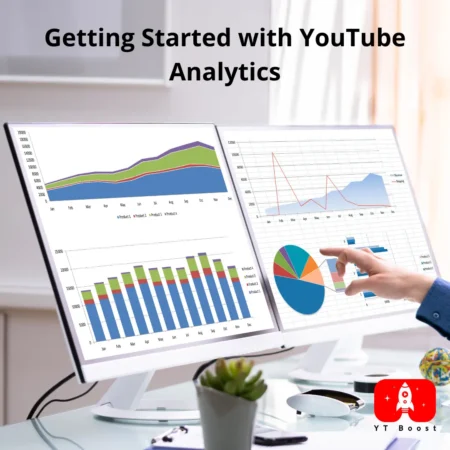
How to Monitor YouTube Analytics?
How to Monitor YouTube Analytics?
If you’ve ever wondered how to effectively monitor your YouTube analytics, you’re not alone. Understanding YouTube analytics is crucial for any content creator who aims to grow their audience and enhance engagement. The first step towards monitoring your analytics is to familiarize yourself with the YouTube Studio, where you can access a plethora of metrics that provide insights into your video performances. By utilizing these insights, you can make data-driven decisions that will ultimately help you refine your content strategy and optimize your channel growth.
What is YouTube Analytics?
 YouTube Analytics is a powerful tool provided by YouTube that allows content creators to track the performance of their videos and channel. This tool offers a wide range of data, including information on views, watch time, audience demographics, and user engagement, which can help creators understand how their content is being received. Those insights are essential for strategizing future content and maximizing audience reach. By analyzing this data, creators can pinpoint what works well and what needs adjustment, making YouTube Analytics an indispensable resource for any serious YouTuber.
YouTube Analytics is a powerful tool provided by YouTube that allows content creators to track the performance of their videos and channel. This tool offers a wide range of data, including information on views, watch time, audience demographics, and user engagement, which can help creators understand how their content is being received. Those insights are essential for strategizing future content and maximizing audience reach. By analyzing this data, creators can pinpoint what works well and what needs adjustment, making YouTube Analytics an indispensable resource for any serious YouTuber.
Getting Started with YouTube Analytics
To access YouTube Analytics for the first time, log into your YouTube account and navigate to YouTube Studio. Once there, you will find an option labeled “Analytics” in the left-hand menu. Click on it, and you will be greeted with a dashboard showcasing various performance metrics. This initial view can be overwhelming, but over time, you will become accustomed to the different sections and what they represent. The key is to take your time and explore each feature to fully understand the wealth of information at your fingertips.
YouTube Studio serves as the command center for all your content management and analytics needs. The layout is user-friendly, featuring tabs that categorize various aspects of your channel’s performance. You will find sections like “Overview,” “Reach,” “Engagement,” and “Audience” that let you dive deep into specific metrics. Familiarizing yourself with these sections will bolster your ability to monitor performance effectively and make informed decisions regarding your content strategy.
Key Metrics to Monitor
Views are often the first metric that creators check when assessing their video’s performance. A high number of views generally indicates that your content is resonating with your audience. However, views alone do not tell the entire story; they should be analyzed alongside other metrics like watch time and engagement. A spike in views might be due to a viral trend, but without sustained engagement, it may not lead to long-term growth.
Watch time measures the total minutes viewers spend watching your videos. This metric is crucial as YouTube’s algorithm favors videos with higher watch time when recommending content. Analyzing watch time helps you understand which videos captivate your audience and keep them engaged. If a video has a high number of views but low watch time, it could indicate that the content isn’t meeting viewer expectations, thus signaling a need for improvement.
Subscriber growth is a vital indicator of your channel’s health and popularity. It reflects how well your content resonates with viewers and whether they find value in subscribing for future updates. Monitoring subscriber trends can help you identify successful content and adjust your strategy to foster growth. An analysis of subscriber patterns over time can provide insights into what types of videos encourage viewers to hit that subscribe button.
Understanding your audience demographics is essential for creating targeted content. YouTube Analytics provides data on the age, gender, geographic location, and even interests of your viewers. This information allows you to tailor your content to better meet the preferences of your audience. For example, if your analytics reveal that a significant portion of your viewers are young adults from a specific region, you can create content that resonates with that demographic, leading to higher engagement and growth.
Using YouTube’s Built-In Tools
 YouTube Studio is equipped with various features that can enhance your analytics experience. The “Real-Time” section allows you to monitor how your videos are performing as they are published. Additionally, tools for creating custom reports and visualizations help you understand trends over time more effectively. By leveraging these features, you can gain deeper insights into your video performance and audience interaction.
YouTube Studio is equipped with various features that can enhance your analytics experience. The “Real-Time” section allows you to monitor how your videos are performing as they are published. Additionally, tools for creating custom reports and visualizations help you understand trends over time more effectively. By leveraging these features, you can gain deeper insights into your video performance and audience interaction.
The YouTube Partner Program not only allows creators to monetize their content but also provides access to advanced analytics tools. As a partner, you can access features like revenue reports, detailed audience analytics, and additional insights into your videos’ performance. This can significantly enhance your ability to monitor and optimize your content strategy, leading to improved engagement and revenue streams.
Strategies for Improvement Based on Analytics
Using analytics to identify content trends is crucial for staying relevant. By analyzing which videos perform well, you can replicate successful elements in future content. Look for patterns in viewer engagement, such as comments and likes, to understand what resonates with your audience. This data-driven approach not only enhances your content quality but also fosters a loyal audience base.
Monitoring competitor analytics can provide valuable insights into how others in your niche are succeeding. By comparing metrics such as views, watch time, and engagement rates, you can identify strategies that work and apply similar tactics to your own content. This competitive analysis can give you an edge in creating content that stands out in a crowded market.
Analytics are not just for tracking performance; they are a tool for optimization. Use insights from your metrics to refine your video titles, descriptions, and tags. Experiment with different formats and styles based on what has performed well in the past. Continuously optimize your content strategy using analytics feedback to enhance viewer engagement and drive channel growth.
Best Practices for Monitoring YouTube Analytics
To make the most of YouTube Analytics, it is essential to regularly review key performance metrics. Set a schedule to analyze your data weekly or monthly, focusing on trends and changes over time. This consistent monitoring will allow you to stay informed about your channel’s progress and make adjustments as needed.
Establishing clear goals based on analytics insights is crucial for channel growth. Use your data to set specific, measurable, achievable, relevant, and time-bound (SMART) goals. For example, if your analytics indicate a decrease in watch time, aim to increase it by a certain percentage within a specific timeframe by tweaking your content strategy.
YouTube’s algorithm is constantly evolving, and staying updated on changes can help you maintain or improve your visibility on the platform. Regularly review official YouTube announcements and community discussions to understand how these changes may impact your content. Adapting your strategy in response to algorithm updates can significantly enhance your channel’s performance.
Chris Taylor
I'm Chris Taylor, an enthusiastic Content Manager and Copywriter specializing in social media and emerging technologies. My talent lies in creating engaging and relatable content that captures the audience's attention and encourages interaction.
As an expert in social media, I'm always up-to-date with the newest trends, using them to develop content that's not just educational but also enjoyable and widely shareable. Recognizing the power of storytelling in brand development, I'm committed to crafting stories that forge a personal connection with audiences. My combination of attention to detail and creative flair ensures that every content I produce resonates deeply with its intended audience.





